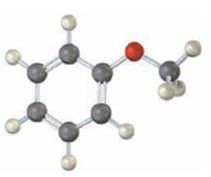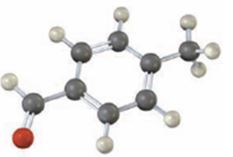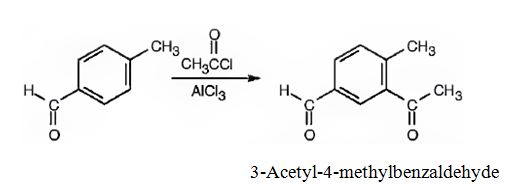
a)

Interpretation:
Draw the products obtained when the compound shown (methoxybenzene) reacts with (i) Br2, FeBr3 and (2) CH3COCl, AlCl3.
Concept introduction:
Aromatic rings can be brominated using Br2 in the presence of FeBr3. The electrophile is Br+. Friedal-Crafts acylation reaction occurs when an
To draw:
The products obtained when the compound shown (methoxybenzene) reacts with (i) Br2, FeBr3 and (2) CH3COCl, AlCl3.
Answer to Problem 24VC
(i) The products obtained when the compound shown (methoxybenzene) reacts with Br2/FeBr3 are p-bromomethoxybenzene and o-bromomethoxybenzene.

(ii) The products obtained when the compound shown (methoxybenzene) reacts with CH3COCl/AlCl3 are p-acetylmethoxybenzene and o-acetylmethoxybenzene.

Explanation of Solution
The methoxy group attached to the benzene ring is an ortho & para directing group. When methoxybenzene is brominated and alkylated it directs the incoming electrophiles, Br+ and CH3CO+ to ortho & para positions.
(i) The products obtained when the compound shown (methoxybenzene) reacts with Br2/FeBr3 are p-bromomethoxybenzene and o-bromomethoxybenzene.

(ii) The products obtained when the compound shown (methoxybenzene) reacts with CH3COCl/AlCl3 are p-acetylmethoxybenzene and o-acetylmethoxybenzene.

b)

Interpretation:
Draw the structures of the products obtained when the compound shown, p-methylbenzaldehyde reacts with (i) Br2, FeBr3 and (2) CH3COCl, AlCl3.
Concept introduction:
Electrophilic substitution of disubstituted benzenes follows three simple rules. (i) If the directing influence of both the substituents reinforce each other, a single product results. (ii) If the directing influences of both the substituent groups oppose each other, the most powerful activating group among them has the dominant influence but usually a mixture of products results. (iii) In meta disubstituted compounds, further substitution in between the groups occurs only rarely, due to steric reasons.
To show:
The major product(s) produced when p-methylbenzaldehyde reacts with (i) Br2, FeBr3 and (2) CH3COCl, AlCl3.
Answer to Problem 24VC
(i) The major product produced when p-methylbenzaldehyde reacts with Br2/FeBr3 is 3-bromo-4-methylbenzaldehyde.

(ii) The major product produced when p-methylbenzaldehyde reacts with CH3COCl/AlCl3 is 3-acetyl-4-methylbenzaldehyde.

Explanation of Solution
The
(i) The major product produced when p-methylbenzaldehyde reacts with Br2/FeBr3 is 3-bromo-4-methylbenzaldehyde.

(ii)The major product produced when p-methylbenzaldehyde reacts with CH3COCl/AlCl3 is 3-acetyl-4-methylbenzaldehyde.

Want to see more full solutions like this?
Chapter 16 Solutions
EBK ORGANIC CHEMISTRY
- Part 1. Draw monomer units of the following products and draw their reaction mechanism (with arrow pushing) Temporary cross-linked polymer Using: 4% polyvinyl alcohol+ methyl red + 4% sodium boratearrow_forwardcan you please answer both these questions and draw the neccesaryarrow_forwardcan you please give the answer for both these pictures. thankyouarrow_forward
- Part 1. Draw monomer units of the following products and draw their reaction mechanism (with arrow pushing) | Bakelite like polymer Using: Resorcinol + NaOH + Formalinarrow_forwardQuestion 19 0/2 pts 3 Details You have a mixture of sodium chloride (NaCl) and potassium chloride (KCl) dissolved in water and want to separate out the Cl- ions by precipitating them out using silver ions (Ag+). The chemical equation for the net ionic reaction of NaCl and KCl with silver nitrate, AgNO3, is shown below. Ag+(aq) + Cl(aq) → AgCl(s) The total mass of the NaCl/KCl mixture is 1.299 g. Adding 50.42 mL of 0.381 M solution precipitates out all of the Cl-. What are the masses of NaCl and KCl in the mixture? Atomic masses: g: Mass of NaCl g: Mass of KCL Ag = 107.868 g mol- 1 Cl = 35.453 g mol- 1 K = 39.098 g mol- N = 14.007 g mol−1 Na = 22.99 g mol−1 0 = 15.999 g mol 1 Question Help: ✓ Message instructor Submit Questionarrow_forwardPart 1. Draw monomer units of the following products and draw their reaction mechanism (with arrow pushing) Polyester fiber Using a) pthalic anhydride + anhydrous sodium acetate + ethylene glycol B)pthalic anhydride + anhydrous sodium acetate + glycerolarrow_forward
- Identify the missing starting materials/ reagents/ products in the following reactions. Show the stereochemistry clearly in the structures, if any. If there is a major product, draw the structures of the major product with stereochemistry clearly indicated where applicable. Show only the diastereomers (you do not have to draw the pairs of enantiomers). If you believe that multiple products are formed in approximately equal amounts (hence neither is the major product), draw the structures of the products, and show the detailed mechanism of these reactions to justify the formation of the multiple products. If you believe no product is formed, explain why briefly. (6 mark for each, except f and g, which are 10 mark each)arrow_forward3. What starting material would you use to synthesize 3-hydroxypentanoic acid using a NaBH4 reduction?arrow_forward1. Give stereochemical (Fischer projection) formulas for all (but no extras) the stereoisomers that could theoretically form during the reduction of a. the carbonyl group of 2-methyl-3--pentanone b. both carbonyl groups of 2,4-pentanedione (careful!) 2. Predict the products of the reduction of O=CCH2CH2CH2C=O with a. LiAlH4 b. NaBH4 CH3 OHarrow_forward
 Organic Chemistry: A Guided InquiryChemistryISBN:9780618974122Author:Andrei StraumanisPublisher:Cengage Learning
Organic Chemistry: A Guided InquiryChemistryISBN:9780618974122Author:Andrei StraumanisPublisher:Cengage Learning Organic ChemistryChemistryISBN:9781305580350Author:William H. Brown, Brent L. Iverson, Eric Anslyn, Christopher S. FootePublisher:Cengage Learning
Organic ChemistryChemistryISBN:9781305580350Author:William H. Brown, Brent L. Iverson, Eric Anslyn, Christopher S. FootePublisher:Cengage Learning EBK A SMALL SCALE APPROACH TO ORGANIC LChemistryISBN:9781305446021Author:LampmanPublisher:CENGAGE LEARNING - CONSIGNMENT
EBK A SMALL SCALE APPROACH TO ORGANIC LChemistryISBN:9781305446021Author:LampmanPublisher:CENGAGE LEARNING - CONSIGNMENT


